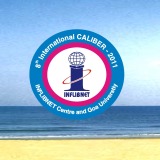Goa University Library
Download: How to reach? | Tour Programme
 Goa University was established in 1985 by incorporating the Centre for Post Graduate Instruction & Research (CPIR) of the University of Bombay. Over the last 25 years, the University has steadily expanded its reach, both in terms of the number of colleges affiliated, as well as the diversity of courses offered. The University has 24 Post Graduate Departments and 3 Centres that offer academic programmes leading to Masters, M.Phil and Ph.D. degrees across six faculties - Faculty of Languages & Literature, Faculty of Social Sciences, Faculty of Natural Sciences, Faculty of Life Sciences & Environment, Faculty of Management Studies, and Faculty of Commerce. The Post Graduate Departments and Centres at the University and the 47 affiliating professional and non-professional colleges provide diverse learning opportunities through degree, diploma and certificate courses, reaching out to students across the state as well as to students from other parts of the country.
Goa University was established in 1985 by incorporating the Centre for Post Graduate Instruction & Research (CPIR) of the University of Bombay. Over the last 25 years, the University has steadily expanded its reach, both in terms of the number of colleges affiliated, as well as the diversity of courses offered. The University has 24 Post Graduate Departments and 3 Centres that offer academic programmes leading to Masters, M.Phil and Ph.D. degrees across six faculties - Faculty of Languages & Literature, Faculty of Social Sciences, Faculty of Natural Sciences, Faculty of Life Sciences & Environment, Faculty of Management Studies, and Faculty of Commerce. The Post Graduate Departments and Centres at the University and the 47 affiliating professional and non-professional colleges provide diverse learning opportunities through degree, diploma and certificate courses, reaching out to students across the state as well as to students from other parts of the country.
Geographically, Goa is located in an ecologically sensitive region along the Western Ghats and the Arabian Sea. Goa University has appropriately emerged as an important resource centre for research in the field of flora and fauna endemic to this region, as well as the marine environment. In recent times, the University has awarded several research degrees in the field of Marine Sciences, Marine Microbiology, Marine Biotechnology, etc. The Ministry of Earth Sciences has recognized Goa University's significant contribution in this domain, as a consequence of which the Department of Earth Science of the Govt. of India has established at Goa University the Ocean Science & Technology Centre (OSTC), a Zonal Centre to coordinate Ocean Science and Technology Research in the Western Zone of India. The Department of Microbiology has been recognized as a Centre of Excellence in Marine Microbiology. A national facility for marine microbial cultures for national utility is also planned.
In addition to the conventional graduate and post graduate programmes, Goa University has also taken initiatives to provide innovative programmes. Some noteworthy initiatives include the Interactive Distance Education Programme in Information Technology, online programme in Geographic Information Science (GIS) in collaboration with the University of Salzburg, Study India Programme in collaboration with Nihon University, Japan, programme in Clinical Research in collaboration with Bioinnovate Research Services, etc.
With a view to promote academic interaction and learning, the University has also signed Memorandum of Understanding (MoU) with many national and international institutions, notably National Institute of Oceanography, Goa; IGNOU, New Delhi; Shivaji University, Kolhapur; Bhabha Atomic Research Centre, Mumbai; National Centre for Software Technology, Mumbai; University of Porto and University of Aveiro, Portugal; Nihon University, Japan; University of Colima, Mexico; International Rice Research Institute, Philippines and others.
Goa University provides a vibrant learning atmosphere for students. Its green campus is renowned for its biodiversity. The students' hostels, facilitation centre, sports and fitness centre, common Internet access facilities and the well equipped library provide the requisite amenities for students to pursue their academic goals amidst an invigorating atmosphere.
Goa and its Climate
The Climate during March in Goa is near perfect with cloudless blue skies, warm but not oppressively hot days, and calm seas. By mid-March the humidity starts to rise as the monsoon begins to approach second time during the year. Summer in Goa sets in by mid-March and remains till the end of June. Though strong heat wave conditions are not encountered, the temperature may rise up to 40 degrees on some days. The average daily sunshine is 9 to 10 hours in summer. The breeze that blows from the seaside continuously has a soothing effect. Light cotton clothes will be comfortable for the hot and humid climate of Goa.
How to Reach?
Air: Gao is very well connected with air network and most important cities of the country are well connected with it. The Dabolim Airport of Goa is located 30 km from Panaji, the capital city of the state. It is situated near Vasco-da-Gama, the port town of Goa. The airport is owned by Indian Navy and various national and international flights are operated. Some of the major airlines which have regular flights to and from Goa; those are Indian Airlines, Jet Airways, Spicejet, JetLite, Kingfisher Red, Kingfisher Airlines, Paramount Airways, IndiGo Airlines and MDLR Airlines.
Road: Goa is connected by good motorable roads with all the major towns in India via the National Highways NH4A, NH17, NH17A.
Train: Goa is directly connected with Ahmedabad, Bangalore, Bhopal, Chennai, Delhi, Emakulam, Gandhidham, Jaipur, Jodhpur, Mangalore, Miraj, Mumbai, Pune, Rajkot Thiruvananthapuram and other cities by rail. Convenient stations in Goa are Margao, Vasco, Karmali and Thivim. Margao (Madgaon) is the main station where all trains stop. Express train of the Konkan Railway line connects Goa with Delhi, Mumbai, Thiruvananthapuram and Vadodara.
Download: How to reach? | Tour Programme
|


